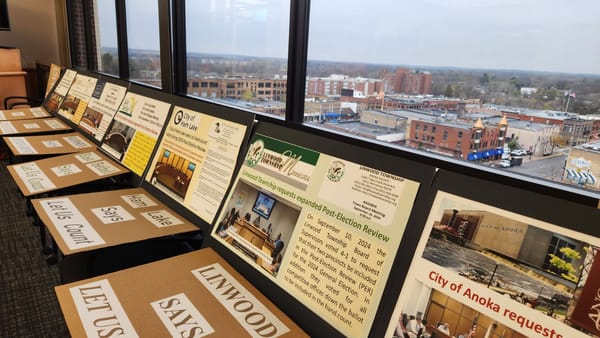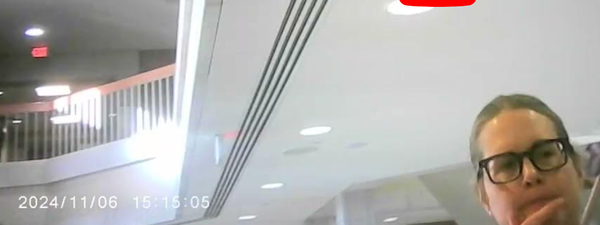Steve Simon Fears Disinformation Taking Root as Crow Wing County Commissioners Pass Resolution Seeking His Support for a Forensic Audit of the November 3rd, 2020 General Election
Will the Minnesota Secretary of State Stoke Division or Restore Confidence?
This is part 2 of a developing story in Crow Wing County and Minnesota election freedom generally. Read part 1 here.
For the November 3rd, 2020 General Election, in Crow Wing County, 40,323 votes were cast for the presidential race. Incumbent Donald Trump received 25,676 votes (63.7%), while Joe Biden received 13,726 votes (34.0%) of the total. Why then did presumably so many Trump voters show up to five consecutive Crow Wing County commissioner meetings requesting an audit of their election? Surely they didn't think there was so much fraud that it could affect their county, let alone the entire state which Biden officially won in a sizable 7.2 point margin?
And yet on January 4th, 2022, the Crow Wing County Commissioners with a vote of 4-1 passed a resolution (video) to request authority from the Minnesota Secretary of State to conduct a forensic audit of their 2020 General Election. This was the first resolution of its kind in the state. At the meeting, before the resolution was voted upon, Pastor Ben Davis thanked both the commissioners and the people who had continued to get involved.
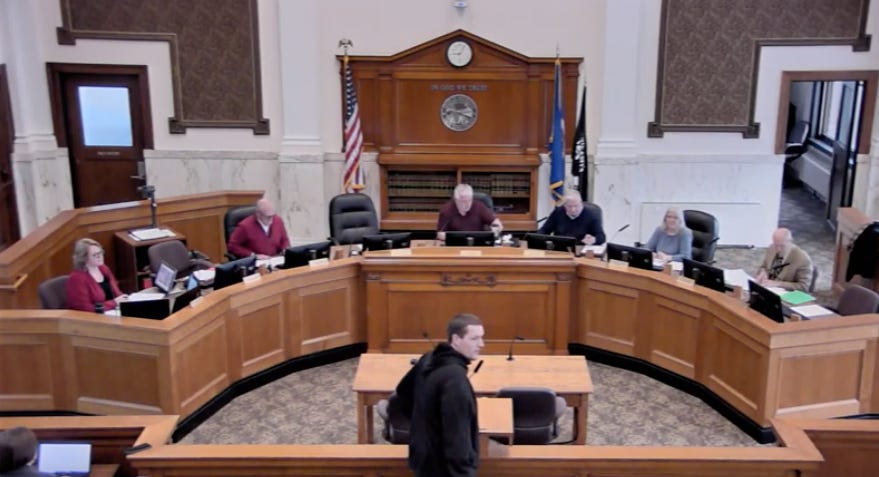
To the commissioners he said, “You did what you believed in your heart you could do and so I want to thank you very much for that.” He followed that up by saying, “I think it’s a very healthy America when we have the people getting involved. And so I want to thank all the folks who came here as well—thank you for getting involved—thank you. This is what a healthy America looks like. And I’m so grateful that we get to exercise this freedom…”
According to the Star Tribune's coverage, the Secretary of State Steve Simon said in response to the events in Crow Wing County, "Unfortunately this is another example, I fear, of disinformation taking root. A generalized feeling or vibe or hunch — and it's probably being stirred up and whipped up by those with a political or financial interest in corroding democracy."
This reply may demonstrate limited knowledge of the many regular people working tirelessly throughout the 15 months since November 2020 to better understand how elections work, could work better, or don't work at all (depending on whose point of view you take), in Minnesota, including those who organized the Searching for Truth event at the Brainerd Exchange in December 2021.
Furthermore, Steve Simon seems to imply that there were not in fact any issues with the Crow Wing County election on November 3rd, 2020. How can he know this in advance of any investigation or audit? It seems to contradict his admission in a 2021 hearing before a Senate elections committee that there is some fraud, although it is "a tiny amount", in every Minnesota election.
During that same remote hearing, Steve Simon also said, "Any member, regardless of party or any testifier regardless of viewpoint who indulges that kind of recklessness, who tolerates it, who encourages it or even hints at it is, I must say, coating themselves in a shame that will never, ever wash off."
So, to date, Mr. Simon has already admitted there is fraud in every election but meanwhile cautions people, including lawmakers, against repeating "politically-inspired lies.”
Instead of name-calling, wouldn't it be easier to show the people who he represents—all the people of Minnesota—any diligence he has done and let the people examine it to make up their own mind?
The fact that risk-limiting audits were done post election does not answer the questions the people of the county are asking relating to the absentee ballot chain of custody, the exposure of voter rolls and histories to inflation, or the potential connectivity of poll books or other equipment to the internet before, during, and after the election (which in the case of the new absentee ballot process, lasts about 47 days). The concerns of the people go well beyond what a risk-limiting audit would detect.
On a related matter, for instance, many in Minnesota are still interested to discover what is being done, if anything, about known ballot harvesting schemes in Minneapolis reported in this video in September 2020, wherein a ballot harvester self-incriminates himself.

Of course, ballot harvesting is only one piece of a large puzzle that makes up the preparation for, conducting of, and processing of an election.
Let's take these three areas one at a time.
Preparing for the Election
When I called half a dozen county clerks in Summer 2020, they seemed mostly confident, with a couple exceptions, about their election systems and processes. Some hesitation can be forgiven in this climate, but also given that as Rick Weible has said, "There are two elections in Minnesota." One that happened on November 3rd, 2020. The other is the absentee ballot election, which was actually a 47-day process that started before election day and extended beyond it.

In a clip from WCCO recorded on October 25, 2020, Secretary of State Steve Simon confirms that it is true that ballots can be postmarked up to November 3rd, 2020, and so long as they are received within seven days, they can still be counted. What was left out was how exactly that process came to be...
Take note of Rick Weible's and Susan Shogran Smith's presentation (74 slides) from the Searching for Truth (3-hour livestream) event in Brainerd on December 9th, 2021. (It appears based on this article that the Brainerd Dispatch sent a reporter with a camera to the event, but the bulk of the substantive content from the more than two hours of presentations was not shared—a missed opportunity to educate its local readers who could not our chose not to attend.)
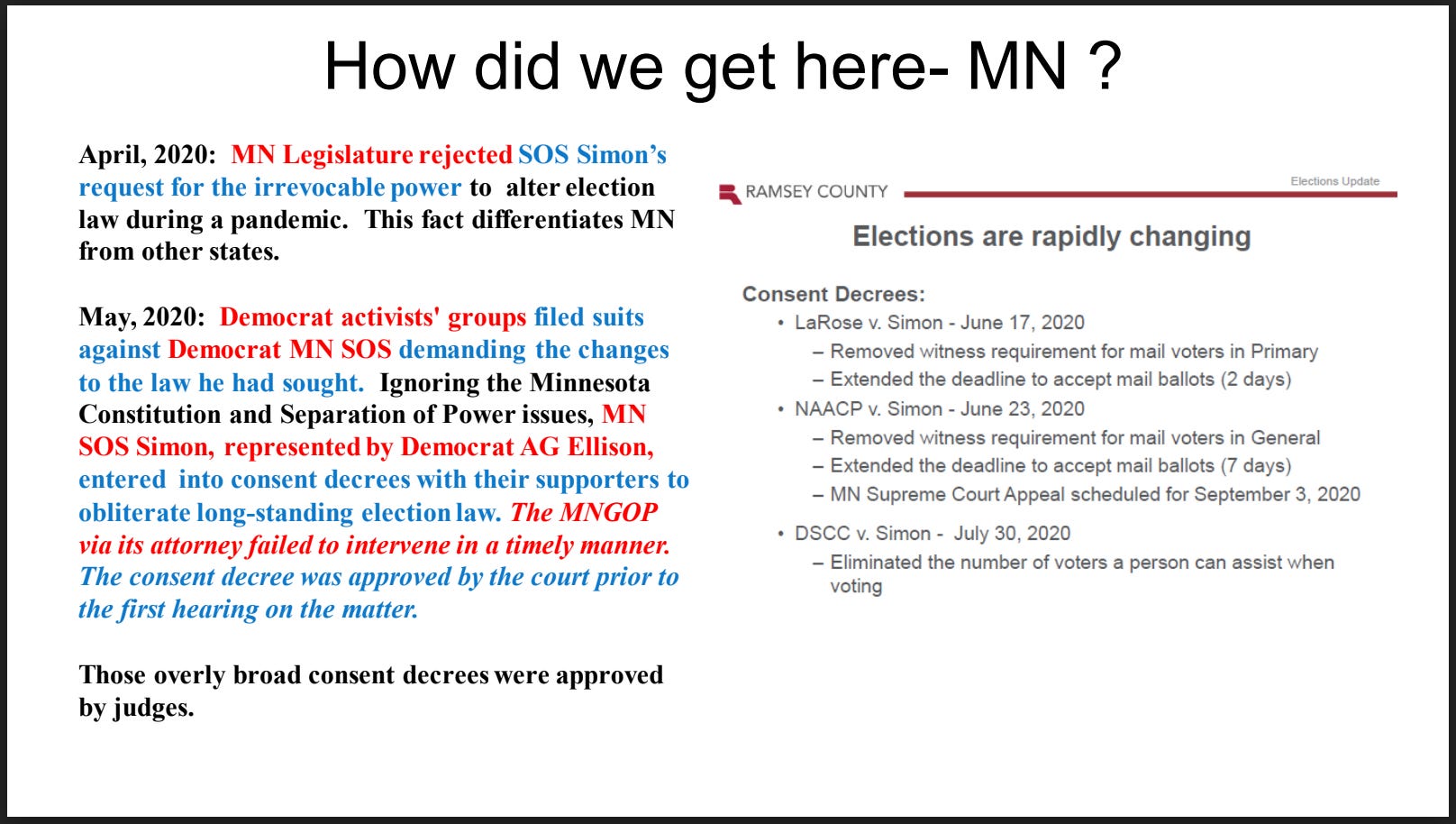
Also relevant in the preparation category is the recent January 4th, 2022 Supreme Court hearing in Minnesota Voters Alliance, et al. v. County of Ramsey, et al. Regarding the case, on which the MN GOP Chairman David Hann stated:
"This case is about ensuring that county and local governments are following the law with respect to election judges and absentee ballot boards. State law clearly provides for our major political parties – both Republicans and Democrats – to help recruit and staff election judges for polling places and absentee ballot boards. The local governments in this case chose not to follow these provisions in our state law, and we are asking the court to put a stop to that. We hope the Court will see the merits of this case and tell local governments to follow the law with respect to election administration.”
Conducting the Election
Regarding the actual conducting of the election, there are numerous issues a casual observer or researcher might look into, whether by reviewing state election laws and statutes, election procedures, or by taking part in the election process oneself as an election judge.
At minimum, every Minnesotan should know their local laws and statutes—this suggestion is not limited to election law. Of particular interest for the 2020 election and going forward are the statutes on absentee voting.
According to Minnesota Statute 203B.121, subdivision 2, "Upon receipt from the county auditor, municipal clerk, or school district clerk, two or more members of the ballot board shall examine each signature envelope and shall mark it accepted or rejected in the manner provided in this subdivision."
In Minnesota Statute 203B.121, subdivision 3, it states, "When applicable, the county auditor or municipal clerk must immediately record that a voter's absentee ballot has been accepted. After the close of business on the seventh day before the election, a voter whose record indicates that an absentee ballot has been accepted must not be permitted to cast another ballot at that election. In a state primary, general, or state special election for federal or state office, the auditor or clerk must also record this information in the statewide voter registration system.”
Rick Weible has shown that more than 700,000 absentee ballots were not connected with a voter in the Statewide Voter Registration System (SRVS) as they should have been on November 29th, 2020, only five days after the Canvassing Board certified Minnesota's election on November 24th, 2020. Should the Canvassing Board have certified Minnesota's election before this work, as indicated by the election laws and statutes, was complete? Since the Secretary of State has access to all this data and correspondence with the county clerks, there should be no problem in providing an explanation. And yet to my knowledge none has yet been given.
Next, let's take a look at data provided by the Secretary of State's website.
At the state level, 2,193,411 absentee ballots were transmitted. 47,000 replacements (2.14%) were transmitted. 8,044 were undeliverable (0.37%). 112,856 ballots were spoiled or lost (5.15%). 1,929,945 were returned (87.99%). 1,909,701 were accepted (87.07%). 20,240 were rejected (0.92%).
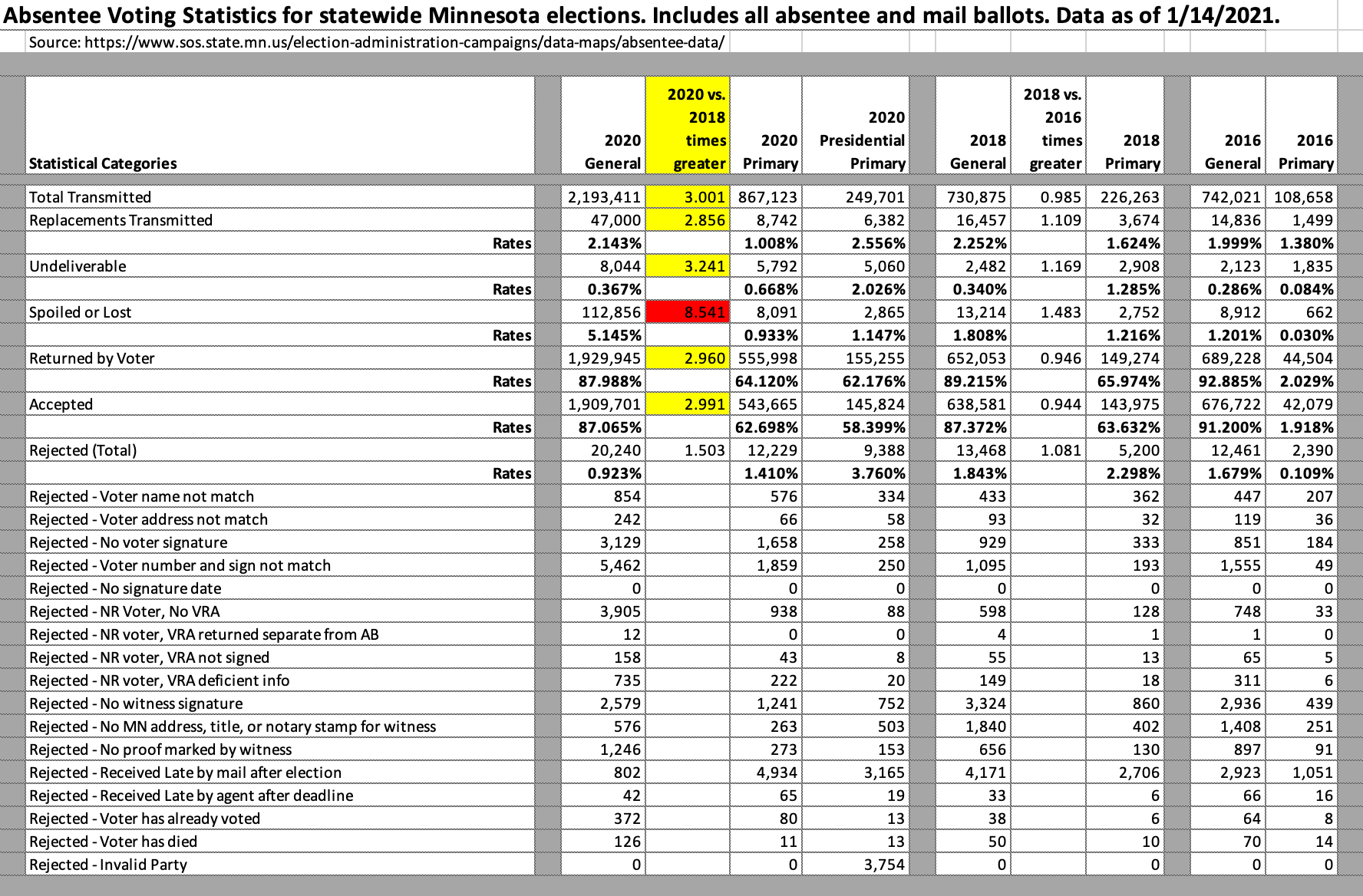
Why were replacements transmitted and what happened to the ballots that were undeliverable? What is the process for the 112,856 ballots that were spoiled or lost? How many were spoiled? How many were lost? What happened to them? With a large rate of rejection, almost 1 out of 100, can Minnesotans be confident that some marginal ballots were accepted that should not have been, or that some were rejected that shouldn't have been?
For Crow Wing County, 24,188 absentee/mail-in votes were cast. 60.0% of all ballots. With the updated procedures relating to the absentee ballots in particular, is it not a reasonable question to ask whether such large volumes were handled correctly?
Processing the Election
On the night of November 3rd, 2020, any Minnesotan watching the nationwide election would have seen what tens of millions across the country also saw: a mysterious pause to vote-counting in the so-called battleground states. Why a reported water leak in Georgia should shut down counting in other states remains unclear.
Meanwhile, in Minnesota, President Biden emerged with a 7.2 point victory. Given the large margin of victory, Minnesota Attorney General Keith Ellison's tweet on November 3rd around 3:57pm was odd: he encouraged Minnesotans to find a friend, even new friends, because "We don't have all of the votes we need quite yet." With several hours still remaining to vote, who is "we" and how did Ellison know that whoever "we" was didn't have the votes?
If you’ve voted, great! Can you please call a friend? Spend a little time getting friends, fams, and folks out to the polls. We don’t have all of the votes we need quite yet. So, help a friend (even a brand new friend) vote. Right now would be awesome.
— Keith Ellison (@keithellison) 9:57 PM ∙ Nov 3, 2020
Going forward, and with further elections to prepare for, Secretary of State Steve Simon has a great opportunity to begin to showcase a dedication to a fair and transparent election process. He has a tough job, as does anyone in charge of elections for an entire state. In Minnesota, more than 5.7 million people (2020 US census) are counting on him.
One way to resolve the uncertainty could be to map the entire process.
For example, here's a diagram of the election system created by Patrick Colbeck of letsfixstuff.org.
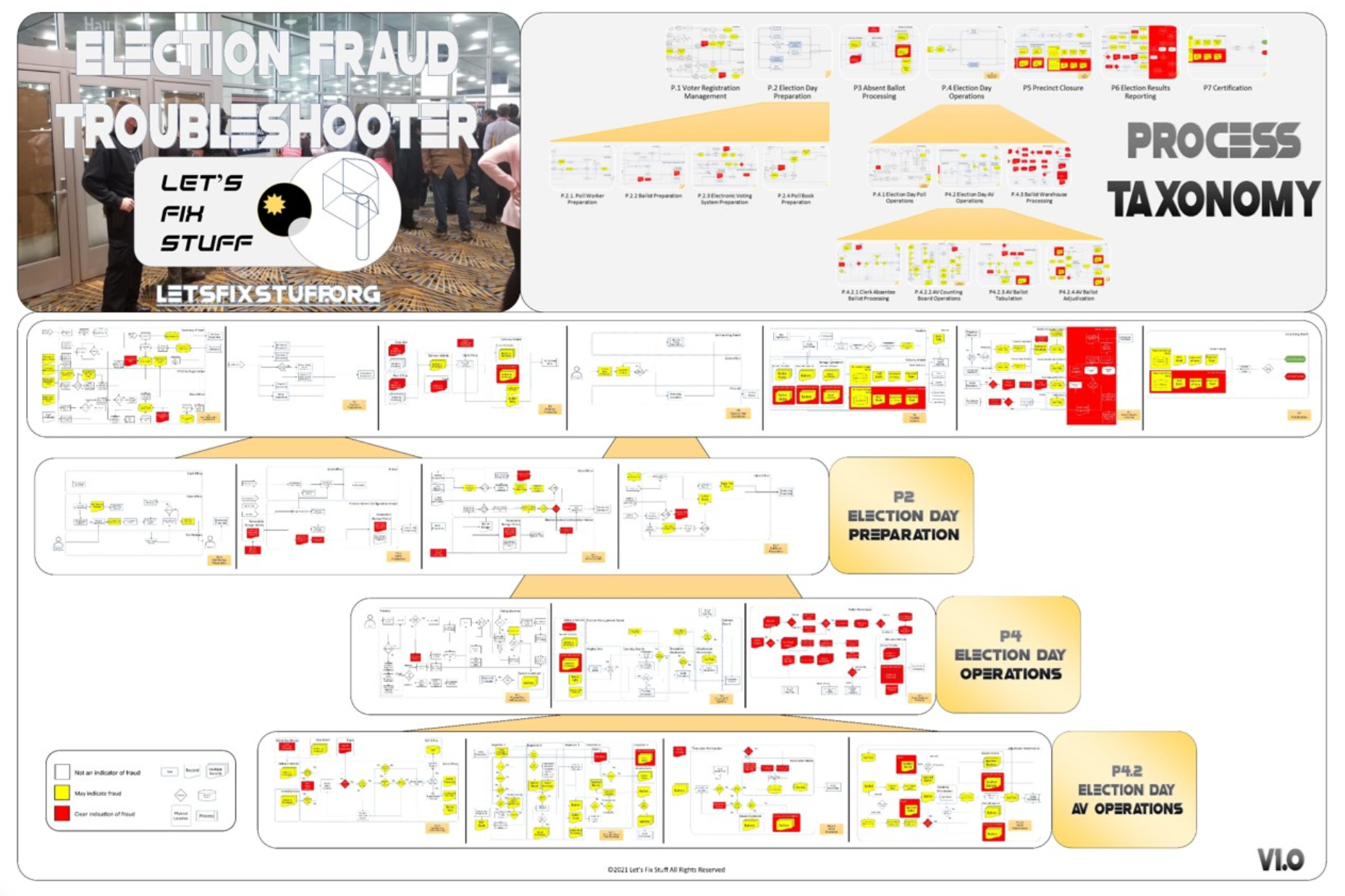
Secretary of State Steve Simon could provide a map similar to the above to help Minnesotans explore and understand which parts of the current system are secure, and which are less secure. If his position is that the current end-to-end election process and systems are 100% or nearly 100% secure, then it would be interesting to understand from his point of view which areas were previously vulnerable, which presumably was the reason he took $6.6 million in federal Help America Vote Act (HAVA) dispersed to Minnesota in 2018. The Star Tribune reported on same here. In that article, Steve Simon is reported as proposing an additional $400,000 "to help train election workers around the state, as Simon has underlined that just nine counties have full-time workers dedicated to elections administrations." For such an important matter as our elections, I tend to agree with the Secretary of State that more full-time workers might be supported.
In March of 2019 Steve Simon re-released a 20-point plan for $6.6 million in federal election security funding which included the stated desire to "modernize our voter registration system." What was the outcome of the $1.5 million dedicated to improving the Statewide Voter Registration System (SVRS)?
It is odd that Secretary of State Steve Simon doesn't take the opportunity to address the fairly simple questions being raised so far, for instance on the matter of the 700,000 ballots not connected to a voter raised by Rick Weible. If the Statewide Voter Registration System (SVRS) had been modernized, would such a variance have occurred?
While it could be said that the above process map would be a detailed and time consuming endeavor, it is also the Minnesota Secretary of State's role to oversee the state's elections in Minnesota. Yes, the county clerks in each of the 87 counties will be quite aware and probably in most if not all cases either be following or believe to be following procedures exactly, but if anyone has a detailed holistic view of how our elections are prepared for, conducted, and processed, it is the Secretary of State himself and his staff.
A rigorous approach to restoring confidence would be much appreciated. To quote Attorney General Keith Ellison, “Right now would be awesome.”
Stay tuned for continuing coverage of the Crow Wing County Commissioner’s request for authority from the Secretary of State to conduct a forensic audit as well as other updates related to election freedom.
This is part 2 of a developing story in Crow Wing County and Minnesota elections generally. Read part 1 here.
An excerpt from the article:
"I think restoring people's faith in our elections is an important thing and I think we need to support that. I don't want us to just walk away from this concern. But, our county attorney (Don Ryan) has told us that we can't do anything about this. Minnesota State Statute 204B.40 says that we have to keep these (ballots) for 22 months but we can't open them, but the Secretary of State (Steve Simon) can. I think Ms. Dillon had a good thought. I would like all the citizens to have faith in the integrity of our elections. And I would like to offer a motion to direct staff to bring a resolution to the next meeting asking the Secretary of State to very strongly consider authorizing a request for a forensic audit to ensure the integrity of Crow Wing County's elections for 2020 and for all future elections."
Your help requested:
“…his admission in a 2020 hearing before a Senate elections committee that there is some fraud, although it is ‘a tiny amount’, in every Minnesota election.”
If you can locate the link to this public hearing, that would be greatly appreciated! Simply reply in the Comments with the link.
Links:
https://www.startribune.com/false-fraud-claims-push-crow-county-to-another-review-of-2020-election/600133624/
https://www.senate.mn/committees/committee_bio.html?cmte_id=3101
https://www.projectveritas.com/video/ilhan-omar-connected-ballot-harvester-in-cash-for-ballots-scheme-car-is-full/
https://drive.google.com/file/d/1_Pi1ij6ypQxUK9NeXdTGwD5i3DtfUq5u/view
https://rumble.com/vqi29n-searching-tor-truth.html?mref=bcurr&mc=56blr
https://www.brainerddispatch.com/news/7319903-Event-outlining-2020-election-fraud-claims-encourages-local-involvement
https://www.revisor.mn.gov/statutes/
https://www.revisor.mn.gov/statutes/cite/203B
https://www.revisor.mn.gov/statutes/cite/203B.121
https://www.revisor.mn.gov/statutes/cite/203B.121
https://midwestswampwatch.com/
https://www.sos.state.mn.us/about-the-office/news-room/secretary-simon-details-20-point-plan-for-66-million-in-federal-election-cybersecurity-funds/



